
The Dayak or Dyak or Dayuh are one of the native groups of Borneo. It is a loose term for over 200 riverine and hill-dwelling ethnic groups, located principally in the central and southern interior of Borneo, each with its own dialect, customs, laws, territory, and culture, although common distinguishing traits are readily identifiable. Dayak languages are categorised as part of the Austronesian languages. The Dayak were animist in belief; however, since the 19th century there has been mass conversion to Christianity as well as Islam due to the spreading of Abrahamic religions.

West Kalimantan is a province of Indonesia. It is one of five Indonesian provinces comprising Kalimantan, the Indonesian part of the island of Borneo. Its capital city is Pontianak. The province has an area of 147,307 km2, and had a population of 4,395,983 at the 2010 Census and 5,414,390 at the 2020 Census; the official estimate as at mid 2022 was 5,541,376. Ethnic groups include the Dayak, Malay, Chinese, Javanese, Bugis, and Madurese. The borders of West Kalimantan roughly trace the mountain ranges surrounding the vast watershed of the Kapuas River, which drains most of the province. The province shares land borders with Central Kalimantan to the southeast, East Kalimantan to the east, and the Malaysian territory of Sarawak to the north.
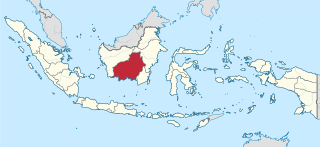
Central Kalimantan is a province of Indonesia. It is one of five provinces in Kalimantan, the Indonesian part of Borneo. Its provincial capital is Palangka Raya and in 2010 its population was over 2.2 million, while the 2020 Census showed a total of almost 2.67 million; the official estimate as at mid 2022 was 2,741,075.
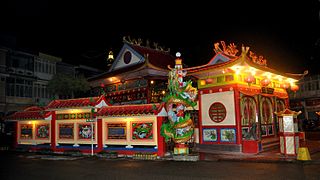
Singkawang or Sakawokng in Dayak Salako or San-Khew-Jong, is a coastal city and port located in the province of West Kalimantan, on the island of Borneo in Indonesia. It is located at about 145 km north of Pontianak, the provincial capital, and is surrounded by the Pasi, Poteng, and Sakkok mountains. Singkawang is derived from the Salako languange, which refers to a very wide area of swamps. In addition, the ancestors of the Hakka Chinese community in Sakawokng also named this area in Hakka as "San-Khew-Jong" (Mount-Mouth-Sea), which means "A city located at the foot of a mountain near the sea and has a river that flows up to the mouth of the river (estuary)."

Bidayuh is the collective name for several indigenous groups found in southern Sarawak, Malaysia and northern West Kalimantan, Indonesia, on the island of Borneo, which are broadly similar in language and culture. The name Bidayuh means 'inhabitants of land'. Originally from the western part of Borneo, the collective name Land Dayak was first used during the period of Rajah James Brooke, the White Rajah of Sarawak. At times, they were also lesser referred to as Klemantan people. They constitute one of the main indigenous groups in Sarawak and West Kalimantan and live in towns and villages around Kuching and Serian in the Malaysian state of Sarawak, while in the Indonesian province of West Kalimantan they are mainly concentrated in the northern Sanggau Regency. In Sarawak, most of Bidayuh population can be found within 40 km of the geographical area known as Greater Kuching, within the Kuching and Serian Division. They are the second-largest Dayak ethnic group in Sarawak after the Iban and one of the major Dayak tribes in West Kalimantan.

Being an indigenous tribe in Borneo, the Kayan people are similar to their neighbours, the Kenyah tribe, with which they are grouped together with the Bahau people under the Apo Kayan people group. The Kayan people are categorised as a part of the Dayak people. They are distinct from, and not to be confused with, the Kayan people of Myanmar.

Punan Bah or Punan is an ethnic group found in Sarawak, Malaysia and in Kalimantan, Indonesia. The Punan Bah people are distinct and unrelated to the semi-nomadic Penan people. Their name stems from two rivers along the banks of which they have been living since time immemorial. They do have other names: Mikuang Bungulan or Mikuang and Aveang Buan. But those terms are only used ritually these days.

The Murut are an indigenous ethnic group, comprising 29 sub-ethnic groups inhabiting the northern inland regions of Borneo. The Murutic languages are a family of half a dozen closely related Austronesian languages. The Murut can be found mainly in Sabah, including in Sarawak, Brunei, and Kalimantan, Indonesia.

Lundu is a town and the capital of Lundu District located in the northwest of Kuching Division of Sarawak, Malaysia, and borders the Indonesian Province of West Kalimantan.

The Banjar or Banjarese are an indigenous ethnic group native to the Banjar regions in the southeastern Kalimantan regions of Indonesia. Nowadays, Banjarese diaspora can be found in neighbouring Banjar regions as well; including Kotabaru Regency, the southeastern regions of Central Kalimantan, southernmost regions of East Kalimantan, and some provinces of Indonesia in general. The Banjarese diaspora community also can be found in neighbouring countries of Indonesia, such as Brunei, Malaysia, and Singapore.
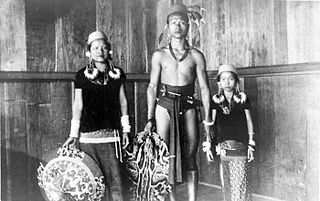
The Kenyah people are an indigenous, Austronesian-speaking people of Borneo, living in interior North and East Kalimantan, Indonesia and Sarawak, Malaysia.
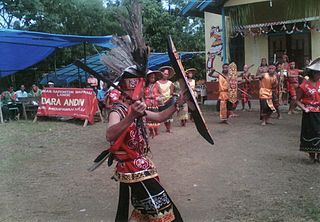
The Kendayan are an Indonesian ethnic group native to Kalimantan, Indonesia in Borneo. The population of the group is around 366,000.
The Ibanic languages are a branch of the Malayic languages indigenous to western Borneo. They are spoken by the Ibans and related groups in East Malaysia and the Indonesian province of West Kalimantan. Other Dayak languages, called Land Dayak, which are not Ibanic, are found in the northwest corner of Kalimantan, between Ibanic and non-Ibanic Malayic languages such as Kendayan and the Malay dialects of Sarawak and Pontianak.

Ma'anyan, Dayak Maanyan or Eastern Barito Dayak people are a sub-ethnic group of the Dayak people indigenous to Borneo. They are also considered as part of the east Barito Dusun group with the name Dusun Ma'anyan. According to J. Mallinckrodt (1927), the Dusun people group is part of the Ot Danum people cluster, although later that theory was disproved by A. B. Hudson (1967), who argues that the Ma'anyan people are a branch of the Barito family. The Ma'anyan people who are often referred to as Dayak people are also referred to as Dayak Ma'anyan. The Dayak Ma'anyan people inhabit the east side of Central Kalimantan, especially in the East Barito Regency and parts of South Barito Regency which are grouped as Ma'anyan I. The Dayak Ma'anyan people also inhabit the northern parts of South Kalimantan, especially in Tabalong Regency which refers to the Dayak Warukin people. The Dayak Balangan people or Dusun Balangan people which are found in the Balangan Regency and the Dayak Samihim people that are found in the Kotabaru Regency are grouped together with the Dayak Ma'anyan people group. The Dayak Ma'anyan people in South Kalimantan are grouped as Ma'anyan II.

Sambas Regency is the most northerly regency in West Kalimantan Province of Indonesia. The regency is one of the original regencies in West Kalimantan, but on 20 April 1999 the southern districts were removed from Sambas Regency to form a new Bengkayang Regency. The residual regency now covers 6,394.70 km2, and had a population of 496,120 at the 2010 census and 629,905 at the 2020 census; the official estimate as at mid 2022 was 647,844. The principal town lies at Sambas.
Sarawak's population is very diverse, comprising many races and ethnic groups. Sarawak has more than 40 sub-ethnic groups, each with its own distinct language, culture and lifestyle. This makes Sarawak demography very distinct and unique compared to its Peninsular counterpart. However, it largely mirrors to other territories in Borneo - Sabah, Brunei and Kalimantan.
Kendayan, or Salako (Selako), is a Malayic Dayak language of Borneo. The exact number of speakers remains unknown, but is estimated to be around 350,000.

Bahau people is a sub-ethnic group of the Dayak people who inhabit West Kutai Regency (9.3%), East Kalimantan, Indonesia.
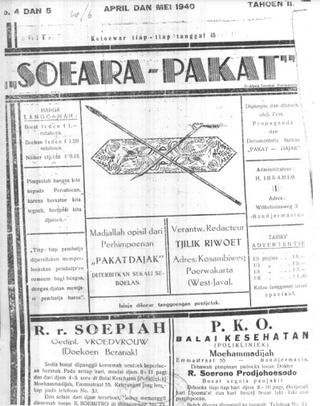
Dayak in politics refers to the participation of Dayaks to represent their political ideas and interests outside of their community. The movement has continued to have a profound impact on the development of Indonesia and Malaysia, especially in Kalimantan and Sarawak.
















